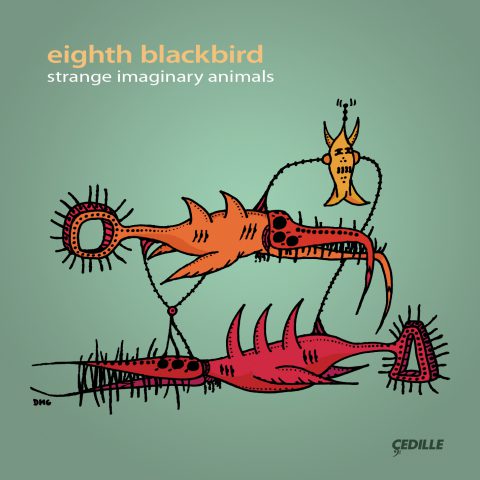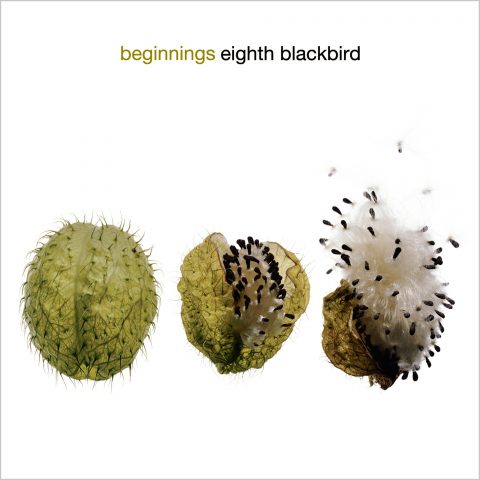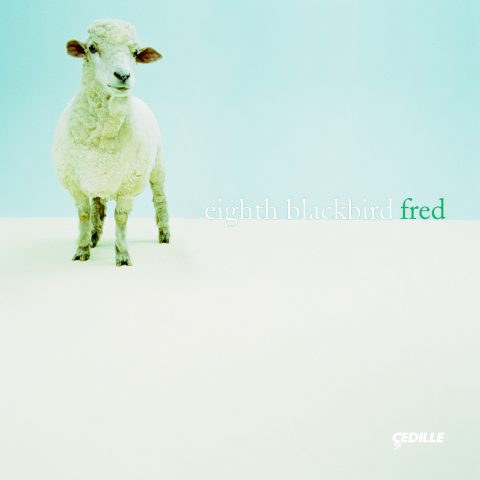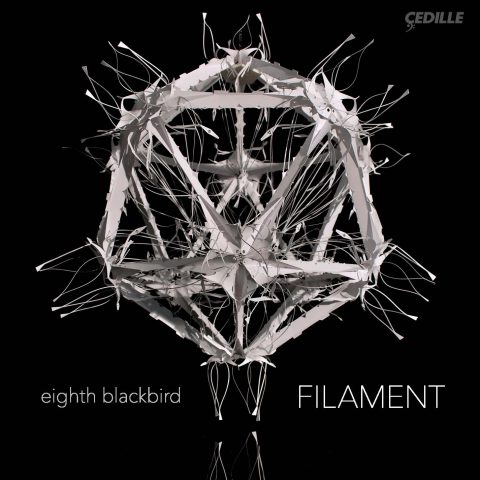Store
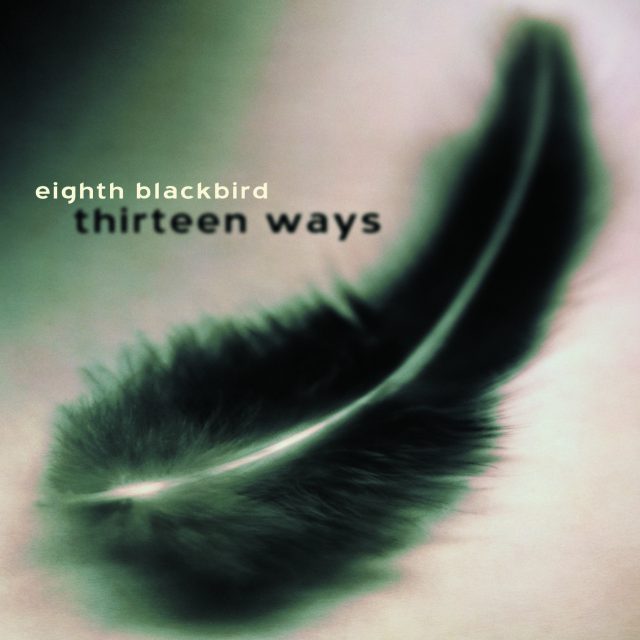
Thirteen Ways is eighth blackbird’s commercial recording debut album on Cedille Records, featuring music by four of America’s most gifted composers:David Schober (b. 1974), Thomas Albert (b. 1948), Joan Tower (b. 1938), and George Perle (b. 1915). Tower’s sparkling Petroushskates is a vibrant homage to Stravinsky; Schober’s elegantly crafted Variations, by turns ethereal and insistent, garnered the 1999 Wayne Peterson Prize from San Francisco State University; Perle’s Critical Moments II, one of the ensemble’s recent commissions, is “remarkably fresh in its spiky crystalline fragments, rapid atonal flurries and muted wisps of sound” (Los Angeles Times); and Albert’s kaleidoscopic Thirteen Ways is as evocative and stimulating as the poem that inspired it.
With its “hip, engaging energy and a sterling musicianship” (Chicago Tribune), eighth blackbird “proves that new music can be both fun and serious” (Detroit Free Press). Even if your tastes tend toward the traditional, you’ll find yourself beguiled by the new CD from “this wise and vivacious ensemble” (San Francisco Chronicle).
Preview Excerpts
JOAN TOWER, b. 1938 (arr. Allen Otte)
GEORGE PERLE
Critical Moments 2
DAVID SCHOBER, b. 1974
THOMAS ALBERT, b. 1948
Thirteen Ways
Artists
Program Notes
Download Album Bookletthirteen ways
Notes by eighth blackbird
Strings, winds, and percussion (including piano) have innately different ways of attacking, sustaining, and ending notes and phrases, and therefore composers have an enormous number of choices to consider when composing for the sextet. We chose these four pieces for our debut recording to illustrate that spectrum of compositional possibility: Tom, Joan, David, and George have written these pieces in distinctly varied styles, but all four works share a sense of intimacy. A sense heightened by the act of listening to a CD — when you listen to a recording, you suddenly become an audience of one. There isn’t anything quite like listening to music in this way. It doesn’t replace the live concert as the ultimate listening experience, but it allows you to become closer to the music on a more personal level. This CD is comprised of music that strongly resonates with every member of eighth blackbird, so getting to know the music in turn acquaints you with each of us as individuals.
Tom Albert knows us (especially Matt, his son) and our playing styles quite well; for instance, he knows of Matt’s love for soaring and meaningful melody, so he incorporated that into many of the movements. He crafted a piece that exploits the low end of the five-octave marimba for Matthew, and he knows that Mike and I have an affinity for blending our sounds to become one. David Schober also knows each of us well — especially his college roommate Matt (what is it with Matt and composers?). I love the opportunity his piece gives us to play with a big, blended orchestral sound — fooling the listener when the flute imperceptibly transforms into the violin, which turns into the cello, and on and on throughout the ensemble. George Perle, a wonderful person whom we met face-to-face for the first time on the day of Critical Moments 2’s premiere, has written a piece that forces us to listen to every part of every note that each of us plays, tremendously refining our ensemble skills during the rehearsal process. Recording Joan Tower’s Petroushskates was for us an opportunity to thank this fabulous woman who has been so instrumental in paving the way for new music ensembles to prosper. Our sextet version of this shimmering soundworld incorporates a percussion part, written by our friend and mentor Allen Otte.
None of these pieces is long or drawn-out; each says what it needs to in a poignant and meaningful way, and then moves on. The various colors and harmonies of each work feed off of and complement one another. We thank you for listening, and while you are — hopefully for the tenth time — please drop us a line or two.1 It’s listening, thinking, feeling, and responding that keeps us, and all new music, going. Thanks for doing your part.
— Molly Alicia Barth
Born in 1938, Joan Tower is at the forefront of today’s contemporary music scene. In addition to commissions from nearly every major orchestra in the United States and several around the world, she has received grants from the Guggenheim and Koussevitsky Foundations, among others. A pianist as well as a composer, she was a founding member of the 1972 Naumburg Award-winning Da Capo Chamber Players. She is currently the Asher Edelman Professor of Music at Bard College, where she has taught since 1972.
In an attempt to understand why figure skating, especially pair skating, was so beautiful and moving to me I discovered a musical corollary I had been working on for a while — the idea of a seamless action. (Skating, of course, has no seams unless you stop!) I also always loved Petroushka and wanted to create an homage to Stravinsky and that piece in particular. As it turned out, the figure skating pairs became a whole company of skaters, thereby creating a sort of musical carnival on ice. The “carnival” idea is further heightened in this arrangement of the piece as a sextet with percussion. The percussion part works well because Allen’s arrangement is subtly done, and Matthew plays it with taste and deference to the other parts. I think it does create a slightly different piece — but mostly one that has been enhanced by the percussion, rather than distracted by it. — Joan Tower
Lisa: The summer of 1997 was the first eighth blackbird spent together. We had put together audition tapes and sent them to various summer music festivals. Amazingly, we got into them all — not bad considering we knew how to play a total of four pieces. One of those was Noon Dance by Joan Tower. We knew that Joan was one of the composers in residence at the Norfolk Festival in Connecticut and we were thrilled at the possibility of playing her piece for her.
Nick: Since it was our first summer at Norfolk, we were there as students (i.e., we paid to go). At that point we had hung out with Joan a little bit, but didn’t really know the depth of her coolness, when we asked her to listen to us play through Noon Dance. So we were a bit nervous — we didn’t know what she was going to think.
Lisa: I’ll never forget that day in July. All six of us were crammed into the shed annex with its noisy air conditioner, friendly mice, and out-of-tune upright piano. Joan sat about two feet away from us as she closed her eyes and listened to us play.
Nick: When we were done, she was silent for some time. She first said, “Wow,” and then made a comment that I remember well, but not precisely. She said that I had actually made the cello solo sound good — she had never been very pleased about how she had composed it and thought that it just would never really work. Suffice it to say this made me very happy.
Lisa: She had tears in her eyes, and told us the reason she hadn’t immediately agreed to listen to us play Noon Dance was that she had never really been comfortable with the work. But she said our performance that day had changed her mind about the piece.
Nick: Since then, how could we not have gotten along with her famously? And how could we not include a work of hers on our first commercial release?
— Lisa Kaplan & Nicholas Photinos
Pulitzer Prize–winning composer and MacArthur Foundation fellow, George Perle was born in 1915 in Bayonne, New Jersey. He was among the first American composers to be influenced by the revolutionary transformation in the language of music embodied in the work of Arnold Schoenberg and the Second Viennese School. From his first encounter with this technique in the summer of 1937, he subjected it to a radical reinterpretation that he calls “12-tone tonality,” which is still the basis of his own musical language. Along with his many compositions, which are widely performed and recorded, Perle has written seven books, including a two-volume study of the operas of Alban Berg. He lives with his wife in New York City and Richmond, Massachusetts.
The instrumentation of these nine short, self-contained, and strikingly individual movements for six players corresponds to that of Pierrot Lunaire, except for the substitution of a percussion part for the quasi-spoken (Sprechstimme) vocal part of Schoenberg’s work. I had taken much pleasure in the composition of a set of six such pieces in 1995–96, and was already strongly inclined to undertake such a project again when an unexpected commission from the Naumburg Foundation gave me an opportunity to do exactly that for eighth blackbird. The nine movements range in duration from 45 seconds to 2 minutes, and there are quite definite structural details in many of the pieces that make their brief duration seem exactly right. But I don’t think I should get into this in the program note — it sort of misrepresents the compositional process, which feels much more intuitive. Above all, I would say, each piece has its own “expression,” in the sense in which Emerson uses that word in his essay, The Poet: “Every line we can draw in the sand, has expression.”
— George Perle
Yes, I’ll have a Citron martini, desert dry, up, with a twist, shaken gingerly. He’ll have the same. Thank you. As I was saying, Critical Moments 2 came to life in quite an unexpected way. As part of our Naumburg prize in 2000, we were awarded a commission by a composer of our choice. Thrilled at this opportunity, we sent in a list of composers we were interested in at the time, all of whom were rejected by the foundation. Excuse me, I said DESERT dry. This tastes like an oil slick. “Not American. Already received a Naumburg commission. Never heard of them. She’s working on an opera and won’t be able to write until 2010.” Obviously, we hadn’t understood the criteria correctly. Before we had time to create a new list, we got word that the foundation had already commissioned George Perle on our behalf. Um hi, I said a twist; these are OLIVES. Imagine our control-freak-y chagrin. A few of us in the group had heard his music before and were shocked by how dramatically different it was from the majority of our repertoire at the time. We had been heading in a distinctly non-academic direction focusing on composers closer to our generation. [Sigh] Getting closer, I’m not quite sure HOW you confused “Citron” for “Peppar” but I’m SURE you’ll get it right this time. With no option for discussion, we kindly thanked the foundation. Now at the time, we were skeptical, but also intrigued: hesitant because George is considerably older and stylistically unlike most of the composers we had commissioned at that point in our career, yet curious about what such a renowned and expert craftsman might come up with. There we go. FABULOUS. We got the parts, rehearsed, performed, and recorded it, and you know what? We’re thrilled with this piece. Each movement is such a microcosm of counterpoint and harmony, with every note serving its own specific purpose and direction. It’s a wonderful complement to the rest of the disc — I recommend putting your CD player on shuffle and letting your ears and mind do a little dance. Kind of like I feel like doing with this excellent martini. You know, the bartenders here are really underrated….
— Michael J. Maccaferri
David Schober (b. 1 9 74) is currently a doctoral candidate and a fellow at the University of Michigan Institute for the Humanities in Ann Arbor. During his undergraduate studies at the Oberlin Conservatory, he received a Theodore Presser Foundation grant to study at Yonsei University in South Korea. National recognition for his composition work has included two BMI Student Composer Awards, an ASCAP Foundation Morton Gould Young Composer Award, the San Francisco State University Wayne Peterson Composition Prize, an Aaron Copland Award, and a Charles Ives Scholarship from the American Academy of Arts and Letters. He has received commissions from the Minnesota Orchestra, the Naumburg Foundation (for the Miró String Quartet), the BMI Foundation/Carlos Surinach Fund, eighth blackbird, and violinist Gregory Fulkerson. His current project is a Fromm Foundation commission for a concerto for eighth blackbird to be premiered with the American Composers Orchestra in 2004.
I’m not sure what to tell you about the “variation s” — it’s true that there’s no theme, and what variation does occur concerns a harmonic unit, primarily, a “motive” only in the general Schoenbergian sense of the Grundgestalt. The harmony is filled in with Messiaen’s Mode 3 (of which the five-note group is a subset) and a dash of Mode 2 (octa – tonic)…. I’ve never analyzed Knussen’s Variations for solo piano in detail, but that piece was a strong influence in terms of gesture and variation technique (i.e., distinct but linked “units” — hardly conventional vari – ations — each recomposing out a basic cell, but not necessarily thematic). That Grundgestalt — A C E B — is a first cousin once removed from mine, a subset of both Mode 2 and Mode 3. Knussen’s piece is more subtle and seamless, clearly with expressive goals different from mine, but a fascinating work.
— David Schober
Dave and I lived together for two years, sharing a dorm room at Oberlin. We both worked most of the time, but I tended to start earlier and Dave continued later. One evening, I remember Dave working on a composition assignment around the time I was going to bed. I wandered over to the little card table he had set up for composing and looked over his shoulder at a diagram filled with chords he had propped vertically in front of him. I was tired, but interested, so I asked him about the chords. He explained the process he was using, and how it was generating the pitches for the piece he was working on. I’m not too bad with theory myself, but as usual at least part of his explanation went over my head. So after letting him explain for about five minutes, I interrupted him, saying, “Well, it’s all just random notes anyway.” There was a beat, and then Dave burst out laughing. After a moment, so did I. Now, years later, somehow those notes of his don’t seem so random anymore.
— Matt Albert
Thomas Albert was born in 1948 in Lebanon, Pennsylvania and educated at Barton College and the University of Illinois. His music has been performed throughout the United States as well as in Europe, Brazil, Japan, and Korea. Two of his works, A Maze (With Grace) and Devil’s Rain, have been a part of the repertoire of Philadelphia’s Relâche Ensemble for many years, and are included on the group’s CD, On Edge. Other recent commissions include incidental music for the University of Cincinnati’s production of Angels in America: Millennium Approaches, The Devil’s Handyman for Washington D.C.’s 20th Century Consort, and a new work for The Folger Consort. He has received grants from the National Endowment for the Arts, the Charles Ives Center for American Music, and ASCAP. He is currently the Associate Dean of the Conservatory and Professor of Music in composition and music theatre at Shenandoah University.
I started the piece with the eighth way because it had a definite musical reference (and more obviously because it was the inspiration for the group’s name). So: noble accents, inescapable rhythms . . . what exactly do those mean? The first idea that came to me was how the simple rhythm of the accompaniment of McCartney and Lennon’s “Blackbird” really propels the song — and does that make it an inescapable rhythm? I thought so. Noble accents . . . I don’t know if they’re noble or not, but the piano constantly interjects accented cluster chords and accented 4-note groups. Both the chords and the 4- note groups are intervallically related to melodic gestures in the “Blackbird” accompaniment. Once that movement was done, I had to find the “hook” for each of the others. The imagery of the poems is very strong, I think, and often visual. I believe my approach to music composition is frequently visually stimulated (in that I might “see” a musical formal correspondent to visual art, or even dramatic art).
The aspect of each poem that “translated” into music for me was different: for some poems, it was a direct depiction of the imagery — almost like underscoring for a film, without the film. For others, the poem merely suggested some musical gesture or form. Finally, a word about overall form. I am fascinated by the Fibonacci series, a numerical pattern in which each number is the sum of the previous two: 1, 1, 2, 3, 5, 8, 13, 21…. There are 13 poems in the set (a Fibonacci number); the group takes its name from the eighth poem (a Fibonacci number). I had originally thought I would somehow connect the first, second, third, fifth, eighth, and thirteenth movements, but that didn’t happen. The first, fifth, eighth, and thirteenth all contain some references to “Blackbird,” but the second and third do not. Some things just don’t work out. However, each movement has a Fibonacci number of measures (13 or 21 or 34 or 55), and many of the movements have rhythmic or formal schemes based on the series in some way.
— Thomas Albert
I hadn’t really attributed any particularly personal connections to the poems. Everyone always imagines their own visuals, etc., especially after so many performances and hearing the poems so many times, but still, it was never a personal connection. Recently, though, I was reading Operating Instructions by Anne Lamott. It’s basically a journal of her baby’s first year, and the entry dated Nov. 3 reads: He laughed today for the first time, when Julie from upstairs was dangling her bracelets above his head while I was changing his diaper. His laughter was like little bells. Then there was the clearest silence, a hush, before total joyous pandemonium broke out between Julie and me. Then we both stared almost heartbrokenly into his face. I thought of Wallace Stevens’s “Thirteen Ways of Looking at a Blackbird,” verse five — I do not know which to prefer, The beauty of inflections Or the beauty of innuendoes, The blackbird whistling Or just after. 2 I’ve never known what to think of that poem, really. But now I think it will always have that association, because it’s so relevant. You have to forgive the one-track mind of an expectant father.
— Matthew Duvall
Album Details
Total Time: 55:30
Recorded: Track 1: October 3, 2002 Pick-Staiger Concert Hall, Evanston, IL
Tracks 2-11: July 15 & 16, 2002 & Tracks 12-24 July 13-14, 2002 Recital Hall of the Performing Arts Center, SUNY Purchase, NY.
Producer and Engineer: Judith Sherman
Assistant Engineer: Hsi-Ling Chang
Editing: Track 1: Bill Maylone
Editing Assistants: Tracks 2-10 Hsi-Ling Chang
Tracks 11-24 Jeanne Velonis
Mastering: Bill Maylone
Front Cover Photograph: © Andy Whale/Stone
Graphic Design: Melanie Germond & Pete Goldlust
© 2003 Cedille Records/Cedille Chicago
CDR 90000 067
